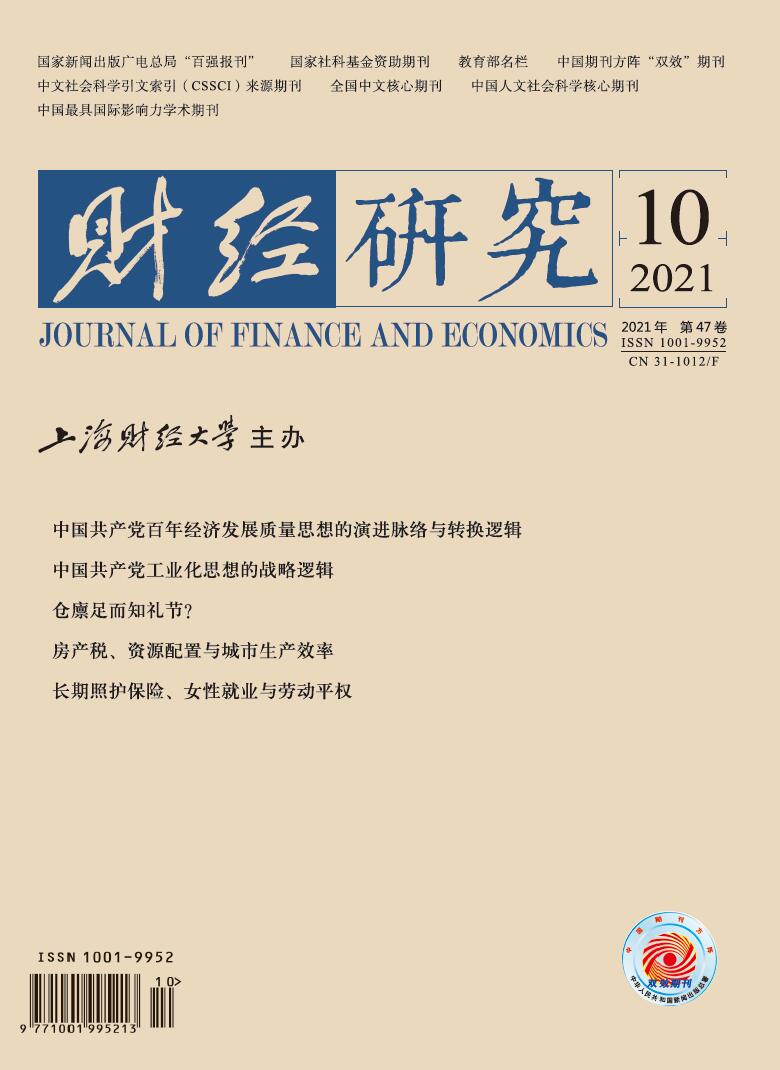推进革命老区绿色高质量发展是新时代我国区域协调发展的重要战略任务,自 2012年以来,国家出台了一系列支持革命老区优先发展的政策措施。为检验国家优先支持政策的影响效果和机制,文章以革命老区2008−2018年的数据为研究样本,运用PSM-DID方法,评估国家优先支持政策对五大重点革命老区的绿色全要素生产率的促进效应。研究表明:(1)国家优先支持政策显著提升了革命老区的绿色全要素生产率,促进了革命老区经济绿色高质量发展;(2)国家优先支持政策对革命老区绿色全要素生产效率的影响机制有三条,即通过智力资本投入、产业结构升级和生态治理实现的;(3)国家优先支持政策对不同城市绿色全要素生产率的促进效应存在异质性,即在工业化水平较低、人力资本水平较低和绿色发展水平较低的城市中的政策效果更强。为了进一步优化政策效果,要加大对革命老区的科技投入和教育投入、促进产业结构升级和推进生态治理,精准制定差异化的扶持政策,培育革命老区经济绿色高质量发展内生动能。
国家优先支持政策促进绿色全要素生产率的效应评估——来自革命老区的经验证据
摘要
参考文献
4 李华旭,杨锦琦. 生态环境约束下农业全要素生产率时空变化研究−以江西为例[J]. 南昌大学学报(人文社会科学版),2020,(3):81−90. DOI:10.3969/j.issn.1006-0448.2020.03.009
8 刘志彪,凌永辉. 结构转换、全要素生产率与高质量发展[J]. 管理世界,2020,(7):15−28. DOI:10.3969/j.issn.1002-5502.2020.07.004
11 宋涛,荣婷婷. 人力资本的集聚和溢出效应对绿色生产的影响分析[J]. 江淮论坛,2016,(3):46−53. DOI:10.3969/j.issn.1001-862X.2016.03.007
19 袁航,朱承亮. 西部大开发推动产业结构转型升级了吗?−基于PSM-DID方法的检验[J]. 中国软科学,2018,(6):67−81. DOI:10.3969/j.issn.1002-9753.2018.06.008
20 张国强,温军,汤向俊. 中国人力资本、人力资本结构与产业结构升级[J]. 中国人口·资源与环境,2011,(10):138−146. DOI:10.3969/j.issn.1002-2104.2011.10.021
24 周永文. 广东环境全要素生产率及影响因素分析−基于环境生产函数的实证研究[J]. 暨南学报(哲学社会科学版),2016,(1):96−112. DOI:10.3969/j.issn.1000-5072.2016.01.010
26 Bernini C,Pellegrini G. How are growth and productivity in private firms affected by public subsidy? Evidence from a regional policy[J]. Regional Science and Urban Economics,2011,41(3): 253−265. DOI:10.1016/j.regsciurbeco.2011.01.005
27 Blundell R,Dias M C. Evaluation methods for non-experimental data[J]. Fiscal Studies,2000,21(4): 427−468.
28 Busso M,Gregory J,Kline P. Assessing the incidence and efficiency of a prominent place based policy[J]. American Economic Review,2013,103(2): 897−947. DOI:10.1257/aer.103.2.897
29 Chung Y H,Färe R,Grosskopf S. Productivity and undesirable outputs:A directional distance function approach[J]. Journal of Environmental Management,1997,51(3): 229−240. DOI:10.1006/jema.1997.0146
30 Färe R,Grosskopf S,Pasurka C A Jr. Accounting for air pollution emissions in measures of state manufacturing productivity growth[J]. Journal of Regional Science,2001,41(3): 381−409. DOI:10.1111/0022-4146.00223
31 Giua M. Spatial discontinuity for the impact assessment of the EU regional policy:The case of Italian objective 1 regions[J]. Journal of Regional Science,2017,57(1): 109−131. DOI:10.1111/jors.12300
32 Grewal B S,Ahmed A D. Is China's western region development strategy on track? An assessment[J]. Journal of Contemporary China,2011,20(69): 161−181. DOI:10.1080/10670564.2011.541626
33 Heckman J J,Ichimura H,Todd P. Matching as an econometric evaluation estimator[J]. The Review of Economic Studies,1998,65(2): 261−294. DOI:10.1111/1467-937X.00044
34 Kline P,Moretti E. People,places,and public policy:Some simple welfare economics of local economic development programs[J]. Annual Review of Economics,2014,6: 629−662. DOI:10.1146/annurev-economics-080213-041024
35 Luenberger D G. Benefit functions and duality[J]. Journal of Mathematical Economics,1992,21(5): 461−481. DOI:10.1016/0304-4068(92)90035-6
36 Romer P M. Endogenous technological change[J]. Journal of Political Economy,1990,98(5): S71−S102. DOI:10.1086/261725
37 Rosenbaum P R,Rubin D B. The central role of the propensity score in observational studies for causal effects[J]. Biometrika,1983,70(1): 41−55. DOI:10.1093/biomet/70.1.41
38 Solow R M. A contribution to the theory of economic growth[J]. The Quarterly Journal of Economics,1956,70(1): 65−94. DOI:10.2307/1884513
39 Zhu Y,Liang D P,Liu T S. Can China’s underdeveloped regions catch up with green economy? A convergence analysis from the perspective of environmental total factor productivity[J]. Journal of Cleaner Production,2020,255: 120216. DOI:10.1016/j.jclepro.2020.120216
引用本文
张明林, 李华旭. 国家优先支持政策促进绿色全要素生产率的效应评估——来自革命老区的经验证据[J]. 财经研究, 2021, 47(10): 65-79.
导出参考文献,格式为:
上一篇:企业跨国并购的协同创新效应
下一篇:数字渗透、金融普惠与家庭财富增长






 3911
3911  4851
4851

